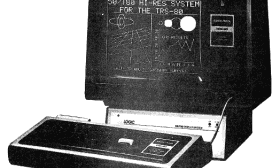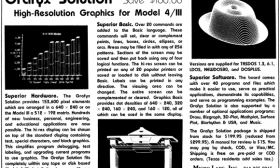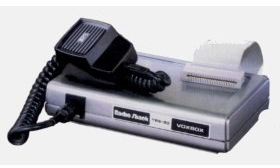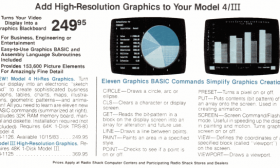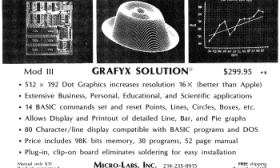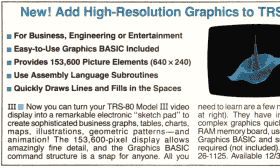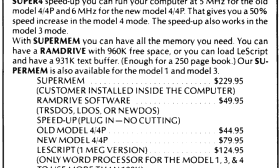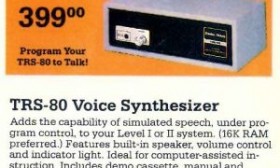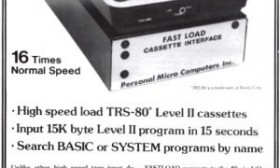Articles in the "Hardware" Category
The SubLOGIC 50/T80 was a high-resolution add-on for the TRS-80 Model I. It was created by SubLOGIC, a company better known to TRS-80 users for their T80-FS1 Flight Simulator.
Here is the text of the 1980 product introduction:
The SubLOGIC 50/T80 system is a high performance professional graphics display system designed to be used directly with the TRS-80. It provides the high-resolution graphics capability which the 80 lacks—the kind of graphics needed for scientific, engineering, and educational applications. Dense drawings, graphs, and even alphanumerics can be put on the 50/T80’s 256 by 240 dot screen. The 50/T80 has the support of SubLOGIC’s 2D and 3D graphics packages, which are powerful and easy to use. They operate easily from BASIC as well as assembly language.
(Read more...)
The Model 4 Grafyx Solution was the most popular high-resolution add-on for the TRS-80 Model 4, and probably the most popular Model 4 add-on in general. It was introduced in 1984 for a price of $199.95 by Micro-Labs, creators of the earlier Model III Grafyx Solution. The Model 4 Grafyx Solution provided true high-resolution access to every pixel on the 640 by 240 Model 4 display, yet was easily user-installable in only a few minutes.
Unlike the Model III Grafyx Solution, which was memory mapped, the Model 4 Grafyx Solution was port-mapped. It used the same ports and mapping as the Radio Shack Model 4 high-resolution board. This meant that the Model 4 Grafyx Solution was almost completely compatible with the Radio Shack board and they could run the same programs. This had the odd side effect of making the Model 4 Grafyx Solution in Model III mode incompatible with the Model III Grafyx Solution.
The Model 4 Grafyx Solution had many advantages compared to the Radio Shack board:
(Read more...)
The TRS-80 VOXBOX (catalog number 26-1181) was an early microcomputer speech-recognition product for the TRS-80 Model I. Introduced in July 1979 by Radio Shack for a price of $169.95, the VOXBOX was described as “electronic ears for your Model I.” The VOXBOX was only available for the Model I; there never was a version for the Model III.
Here is a description of the VOXBOX from a 1980 Radio Shack catalog, where it was paired with the $399 TRS-80 Voice Synthesizer:
(Read more...)
Radio Shack introduced the TRS-80 Microcomputer System, later known as the Model I, in August 1977. It was the first member of the original line of TRS-80 computers. Radio Shack followed the Model I with the mostly compatible Model III in 1980 and then the Model 4 in April 1983. But other than the transportable Model 4P in November 1983 and the improved Model 4D in 1985, there were no further members of this computer family.
Around the time of the development of the Model 4, Radio Shack engineers did plan a computer that could have followed it. Although not known by the name within Radio Shack, this often rumored computer was usually called the “Model 5” or the “Model 4C” by the public.
By considering all of the available bits of information, it is possible to piece together details about the key features of the “Model 5”:
(Read more...)
Radio Shack introduced their high-resolution add-on for the Model 4 (catalog number 26-1126) on October 15, 1983. Just like their Model III high-resolution board, it was never identified by name in any Radio Shack catalog. The official name seems to have been “TRS-80 Model 4 Computer Graphics” but it was usually referred to as the “Radio Shack Model 4 high-resolution board.”
At $249.95, the Model 4 high-resolution board was $80 cheaper than the Model III version. It provided a nearly identical hardware interface to the Model III version, with the same 640 by 240 resolution. It’s interesting to note that the Macintosh screen at the time was 576 by 340.
(Read more...)
The Model III Grafyx Solution was a high-resolution graphics add-on for the TRS-80 Model III. Created by Ted Carter, president of Micro-Labs, the Grafyx Solution was introduced in early 1982 for a price of $299.95. There never was a Model I version of the Grafyx Solution.
The Model III Grafyx Solution used a different approach than 80-GRAFIX, an earlier Micro-Labs product for the Model I and III. While 80-GRAFIX could only simulate high-resolution graphics by redefining the character set, the Grafyx Solution provided full access to the 512 by 192 resolution of the Model III.
No soldering was required to install the Grafyx Solution. Instead, installation consisted of plugging the Grafyx Solution into the Model III and using special micro-clips to attach it to specific pins on chips already in the Model III.
(Read more...)
Radio Shack introduced their high-resolution add-on for the Model III (catalog number 26-1125) on December 30, 1982 for a price of $369.95. It was never identified by name in any Radio Shack catalog but the official name seems to have been “TRS-80 Computer Graphics Package.” Few ever used that name and it was commonly referred to as the “Radio Shack high-resolution board.”
The Model III high-resolution board offered a resolution of 640 by 240. This was the same resolution as the Model II high-resolution add-on that Radio Shack had introduced the previous year, but it was higher than the normal Model III resolution of 512 by 192. There were so many similarities to the Model II high-resolution add-on that I suspect it was the basis for the Model III version.
(Read more...)
The Alpha Technology Supermem was one of the most popular memory expansion options for the TRS-80. Alpha Technology (not to be confused with the similarly named Alpha Products) introduced the Supermem in 1985 for the Model I, Model III, and Model 4 in four memory sizes:
(Read more...)
The TRS-80 Voice Synthesizer (catalog number 26-1180) was a speech synthesizer unit sold by Radio Shack. Introduced in 1979 for a price of $399.00, the unit was only compatible with the TRS-80 Model I; Radio Shack never sold a TRS-80 Model III version.
The TRS-80 Voice Synthesizer plugged directly into the Model I expansion port and worked with both Level I and Level II BASIC systems. Like most voice synthesizers at the time, it worked by outputting words already broken into phonemes, or very small units of sound. It was described this way by the product introduction (under the headline of “Your TRS-80 Speaks!"):
(Read more...)
The FASTLOAD cassette interface used a novel (and patented) method of speeding up loading cassette programs on a TRS-80 Model I. By using a specially modified cassette recorder permanently in fast-forward mode (the equivalent of the fast-forward button always being pressed), FASTLOAD increased cassette loading speeds up to sixteen times to as high as 8000 baud. FASTLOAD was introduced in 1981 by Personal Micro Computers, Inc. (also known as PMC) for a price of $188.00. The modified CTR-41 cassette recorder, required to use FASTLOAD, cost $95.00. Personal Micro Computers also sold FASTLOAD as an option for their PMC-80 and PMC-81 Model I compatible computers.
The FASTLOAD cassette interface connected to the Model I I/O connector and used a built-in ROM to add a new cassette loading routine (mapped to the LOAD command), keyboard debounce routine, automatic key repeat, and a key click feature. Upon startup, a single SYSTEM command was required to enable the FASTLOAD interface routines.
(Read more...)
